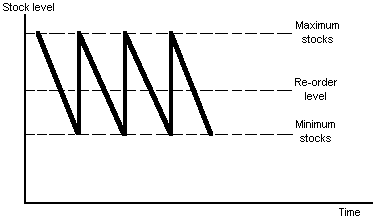Stock Control Systems
1. Fixed re-order stock level
This method of stock control is where a business decides the minimum level of stocks it can tolerate, and then re-orders before the stocks reach this level. The exact timing will depend how long the stocks take to arrive. This can be illustrated as follows:

The distance between the re-order line and the minimum stocks level depends how long it may take for the order to arrive - this time is known as the lead time.
2. Fixed time re-ordering
This method is exactly as its title suggests. The firm re-orders stocks at a fixed time each month or week. It can offer a good solution as it represents a routine for the firm and ensures that stocks are regularly supplemented. However, it may well mean the level of stocks fluctuating quite a bit depending on the rate they are used up. It is a little inflexible as a system as well unless used very carefully.
3. Economic order quantity
For any company there is an optimum level of stocks. The precise level of this will vary in different firms and industries. They have to balance the costs of holding stocks (the space taken, the money tied up, etc...) with the costs of ordering stock. The more firms order at once, the better the deal they will usually get.
The level of stocks that strikes the balance between these two things is known as the economic order quantity. If this is taken to be the optimum level of stocks it should help to minimise the firm's costs - an important pre-requisite to maximising profit.
4. Just-in-time production
Because stocks cost so much to keep, another method of stock-control was developed in Japan and has now become much more common in the UK. The just-in-time method involves keeping stocks to an absolute minimum, and the raw materials are ordered only when they are needed. In other words just-in-time. This time period in some cases has been reduced to minutes or hours, and the raw materials arrive on site moments before they are needed.
This can be wonderful for helping to reduce the need for working capital, but requires a very high level of organisational skill and a very close relationship with suppliers.